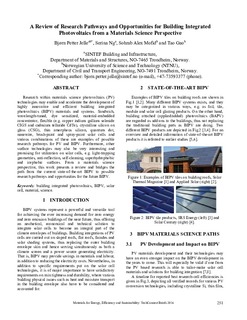A Review of Research Pathways and Opportunities for Building Integrated Photovoltaics from a Materials Science Perspective
Chapter
Published version
Permanent lenke
http://hdl.handle.net/11250/2502046Utgivelsesdato
2016Metadata
Vis full innførselSamlinger
- Publikasjoner fra CRIStin - SINTEF AS [5801]
- SINTEF Community [2247]
Sammendrag
Research within materials science photovoltaics (PV) technologies may enable and accelerate the development of highly innovative and efficient building integrated photovoltaics (BIPV) materials and systems. Sandwich, wavelength-tuned, dye sensitized, material-embedded concentrator, flexible (e.g. copper indium gallium selenide CIGS and cadmium telluride CdTe), crystalline silicon on glass (CSG), thin amorphous silicon, quantum dot, nanowire, brush-paint and spray-paint solar cells and various combinations of these are examples of possible research pathways for PV and BIPV. Furthermore, other surface technologies may also be very interesting and promising for utilization on solar cells, e.g. light-trapping geometries, anti-reflection, self-cleaning, superhydrophobic and icephobic surfaces. From a materials science perspective, this work presents a review and bridges the path from the current state-of-the-art BIPV to possible research pathways and opportunities for the future BIPV.
